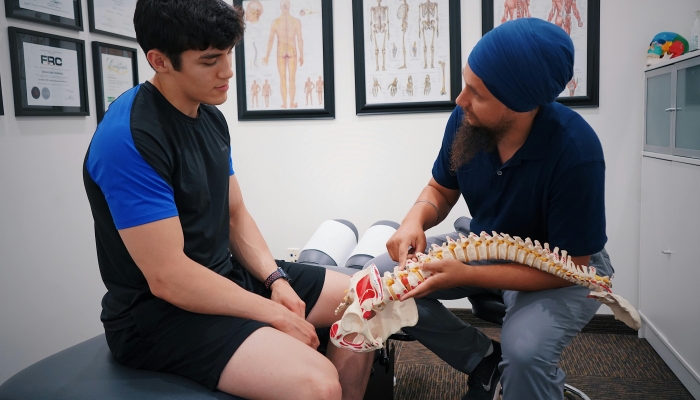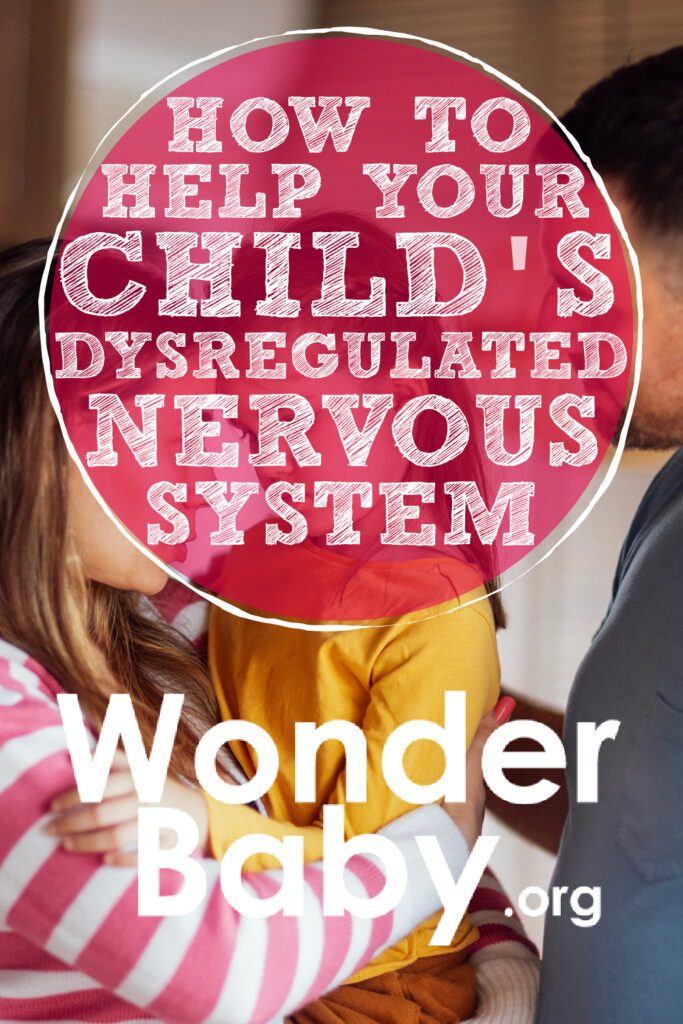How To Help Your Child’s Dysregulated Nervous System

- Our nervous system is the communication system for our body, carrying messages between the brain and the body.
- It’s healthy for our nervous system to dysregulate during times of danger or stress, but frequent nervous system dysregulation can lead to other problems.
- Nervous system dysregulation in a child means that the brain has switched off the ability to connect, think, and reflect.
- Creating a routine with body awareness activities, a balanced diet, sensory strategies, and enough sleep can help your child’s dysregulated nervous system.
- Seek help from professionals if you are concerned with your child’s nervous system dysregulation or if it’s becoming more frequent and impacting daily life.
As a baby, she had a difficult time sleeping. She’d wake often crying. At times, it was hard to soothe her. She had reflux, and we figured that was the problem.
As she grew, she started to have more frequent tantrums that would escalate quickly to hitting or pinching. It began to feel like small things could trigger her quickly.
I hear these concerns often. Parents seek support at this point to try and help their child change their behavior. But first it’s important to recognize what the behavior is communicating.
Frequent meltdowns, irritability, or easily being triggered might indicate a dysregulated nervous system. As a parent, watching your child dysregulate can be overwhelming, exhausting, and potentially dysregulating for you, too.
Techniques to Help Regulate a Child’s Nervous System
The most important thing you can do during these challenging times is stay regulated yourself. Your child needs you to remain calm to become calm again. This is called co-regulation.
If you see your child dysregulating often, incorporating the following techniques regularly can help regulate their nervous system throughout the day and reduce the times they dysregulate.
Consistent Routines

Children thrive with structure. They want to know what to expect. Having a routine will significantly help keep your child’s nervous system regulated.
Set a consistent time for meals and bedtime. Consider that your child has an internal clock. Keeping meal and snack times consistent will make your toddler feel more regulated.
Honor your child’s nap and sleep schedules, too. Create a consistent and calming routine for bedtime. Read books or sing a special song every night for consistency and to help your child’s body naturally relax for sleep.
Although your child may ask to stay up later, remember the importance of a consistent routine. You can be flexible on special occasions but try to remain consistent most other nights.
Sensory Strategies

Sensory processing is our body’s ability to receive, analyze, and organize internal and external input through our senses. Our bodies process information through eight sensory systems:
- Hearing
- Smell
- Sight
- Touch
- Taste
- Vestibular (balance)
- Proprioception (movement)
- Interoceptive (internal)
Sometimes, a child might have difficulty processing sensory information. Their brain struggles to receive and interpret the sensory input. Some kids are over-responsive to sensory stimuli, while others are under-responsive or sensory-seeking. This can lead to a sensory meltdown for some children.
Understanding how your child responds to sensory stimuli can allow you to create a calming environment for their sensory needs. This will help their nervous system, too.
If you think your child has sensory processing needs, consult an occupational therapist (OT) to create the best sensory diet to fit your child’s specific needs. Strategies might include:
- Use of weighted vests or blankets.
- Sensory breaks with tactile toys.
- Specific heavy work.
- Creating a calm sensory space at home.
Mindfulness and Grounding Exercises

Sometimes, a reset or change in scenery can help your child regulate. Mindfulness and grounding activities can help your child become present in the moment and reset.
Grounding activities bring the mind’s awareness back to the environment around you. Practicing grounding techniques can help your child work through intense emotions.
Practice grounding techniques regularly, even and especially when your child is feeling regulated. This will help your child use the technique when dysregulated, too. Try the following activities with your child:
- Deep breathing exercises: Have your child pretend to blow a big bubble.
- Five senses activity: Ask your child to find five things he sees, four things he hears, three things he can touch, two things he can smell, and one thing he can taste.
- Take five: Have your child hold up their hand and use one finger on their opposite hand to slowly trace each finger up and down. As they trace up a finger, they breathe in, and as they trace down, they breathe out.
- Guided imagery or visualization: Have your child imagine a time and place where they felt calm or happy. Have them draw this out. Have them think of their drawing or happy place when dysregulated.
- Simple meditation: Find a short, guided meditation for children. Sit in a quiet and calm space and meditate together.
Physical Activity

Physical activity supports the nervous system. It activates the sympathetic system and helps to regulate responses. Incorporating daily play or movement in your child’s schedule can help regulate your child.
Choose a physical activity based on your child’s interests and physical needs. Yoga can not only increase movement but also mindfulness. Slow, thoughtful movements and awareness of one’s breath can help maintain your child’s nervous system.
Adding music to your child’s physical activity can also help. According to Bruce Perry, MD, PhD,11. MacKinnon, L.. The neurosequential model of Therapeutics: An interview with Bruce Perry. Australian and New Zealand Journal of Family Therapy. 2012;33(3), 210–218. https://doi.org/10.1017/aft.2012.26 senior fellow of the Child Trauma Academy, repetitive and rhythmic activity can help change a dysregulated nervous system. Rhythmic activities include dance, jumping on a trampoline, drumming, or swinging.
Getting your child involved in sports or other outdoor activities can also help regulate his nervous system. Take nature walks and enjoy the outdoors for an added benefit.
Diet and Nutrition

For our bodies to function well, we need to eat a balanced diet. According to a 2018 article review22. Wendołowicz, A., Stefańska, E., & Ostrowska, L.. Influence of selected dietary components on the functioning of the human nervous system. Roczniki Panstwowego Zakladu Higieny. 2018;69(1), 15–21. https://pubmed.ncbi.nlm.nih.gov/29517182/#:~:text=A%20diet%20without%20an%20appropriate,may%20lead%20to%20neurotransmission%20dysfunction. published in the National Institute of Public Health, our brain and nervous system function best when they receive the necessary nutrients of amino acids, glucose, polyunsaturated fatty acids, and specific vitamins and minerals.
This doesn’t mean you must start a new diet to help regulate your child’s nervous system. Instead, be mindful and intentional about the foods you offer. Ensure your child gets balanced meals with fresh vegetables, fruits, and whole grain products. Avoid highly processed foods, foods with high sugar content, and caffeine products.
Staying hydrated is also essential for nervous system regulation. If your child is dehydrated, their sympathetic nervous system is activated, causing nervous system dysregulation.
Remember to offer your child water regularly. If your child is dysregulated, a cool drink of water is a grounding technique that can help calm them. A cool drink of water can activate the parasympathetic system, bringing the body back to regulation.
Understanding the Nervous System

Our nervous system is the communication system for our body, carrying messages between the brain and the body. The nervous system manages our movement, bodily functions, and responses to our environment.
The nervous system has two main parts. The central nervous system is the main control center and contains the brain and spinal cord. The peripheral nervous system contains the nerves that branch out from the central nervous system and connect to the rest of the body.
Within the peripheral nervous system is an important network of nerves called the autonomic nervous system.
The Autonomic Nervous System (ANS)
The autonomic nervous system (ANS) is a system of nerves that help regulate your body’s involuntary processes like breathing, heart rate, and digestion. The ANS is always active. It helps your body prepare to cope with stress or threats and then return to a resting state.
The ANS consists of the sympathetic nervous system and parasympathetic nervous system. The sympathetic nervous system becomes activated during exercise or emergencies. It aims to support our survival through “fight or flight” responses.
The parasympathetic nervous system activates during quiet conditions, sometimes called “rest and digest.” When activated, the parasympathetic nervous system allows us to connect socially with others and access higher brain functions. It is sometimes referred to as the social engagement system.
A regulated nervous system enables us to adjust to environmental changes while remaining stable. A regulated nervous system more easily manages our body’s response to routine changes, stressors, or illness.
Causes of Dysregulation
The ANS becomes dysregulated during times of perceived danger or stress. This can look different for every child. A child may have a dysregulated nervous system due to:
- Traumatic events, from psychological trauma, post-traumatic stress disorder, physical injuries, or abuse.
- Chronic stress or anxiety, prolonged physical or emotional stress can negatively impact stress responses.
- Sensory processing issues.
- Other medical conditions including infections, hormonal imbalances, or from a traumatic brain injury (TBI).
Signs of a Dysregulated Nervous System in Children
Nervous system dysregulation can look different for each individual person. A dysregulated nervous system can be overactive or underactive, thus causing the signs to present differently.
A regulated child is ready to engage socially. They can make eye contact, control their movements, and express their emotions. They are curious and can think through situations.
Nervous system dysregulation in a child means that the brain has switched off the ability to connect, think, and reflect. The ANS is now operating in fight, freeze, or flight response. A child with a dysregulated nervous system may present with physical, emotional, and behavioral symptoms.
Physical Symptoms

A child with a dysregulated nervous system might have trouble sleeping or other sleep problems. This might present as insomnia, restlessness, or difficulty relaxing. If their nervous system is underactive, they may have low energy levels.
Some children suffer from health conditions such as frequent stomachaches or headaches. You may see extreme appetite changes or digestive problems such as constipation or reflux.
Your child might become highly sensitive to sensory inputs because their nervous system is more sensitive to stimuli. They may feel more overwhelmed in certain situations or become easily triggered and upset.
Emotional Symptoms

A dysregulated nervous system impacts a child’s ability to express all emotions. You might see your child have difficulty managing emotions or soothing themselves. This can affect daily activities. Your child might be more irritable or on edge. Sometimes, these mood swings are extreme. This can lead to withdrawal or isolation from peers.
Behavioral Symptoms

Young children with a dysregulated nervous system might have delays in developmental milestones. Although tantrums are developmentally appropriate, a child with a dysregulated nervous system might have more frequent meltdowns or tantrums.
Children might feel scattered or have difficulty concentrating since the higher level of brain functioning (the prefrontal cortex) is switched off during nervous system dysregulation. This can also impact cognitive function and can cause poor memory. Some children are easily distracted and have trouble focusing or have brain fog. You might also see an increase in impulsive behaviors.
Collaborative Approaches
Helping a child through nervous system dysregulation is a collaborative process. It involves increasing connection and implementing strategies tailored to your child’s needs. This may include adjusting your child’s routine at home, therapeutic interventions, and school involvement.
Therapeutic Interventions

Sometimes, it is beneficial to seek help from professionals. Seek support from a pediatric healthcare professional if your child’s nervous system dysregulation is:
- Persistent and severe.
- Impacting several parts of your child’s life.
- Causing developmental delays or regression.
- Concerning for you or other family members.
Depending on your child’s needs, this may include a referral to occupational therapy, play therapy, or another form of psychotherapy.
An occupational therapist (OT) will focus on your child’s sensory needs. This will include sensory integration techniques to help your child understand and regulate emotions and how they respond to specific stimuli.
In play therapy or other forms of psychotherapy, your child has a safe space to process emotions and thoughts while also developing or reinforcing coping skills.
Communication with School

If your child is in school, work collaboratively with teachers and counselors. Seek feedback and support from your child’s educational team regarding behaviors, social and emotional well-being, and progress at school.
Advocate for your child and include your child’s therapists or other healthcare professionals to create a school plan that will best fit your child’s needs. If necessary, this might include implementing breaks or specific supports during the school day and making an Individualized Education Plan (IEP).
Parent Support

Your child’s nervous system dysregulation can impact your well-being, too. It can be exhausting and overwhelming trying to support your child. Make sure to take care of yourself too. Seek support from peers, family, and professionals.
You must take the steps to remain regulated to support your child better.
References
- MacKinnon, L. (2012). The neurosequential model of Therapeutics: An interview with Bruce Perry. Australian and New Zealand Journal of Family Therapy, 33(3), 210–218. https://doi.org/10.1017/aft.2012.26
- Wendołowicz, A., Stefańska, E., & Ostrowska, L. (2018). Influence of selected dietary components on the functioning of the human nervous system. Roczniki Panstwowego Zakladu Higieny, 69(1), 15–21. https://pubmed.ncbi.nlm.nih.gov/29517182/#:~:text=A%20diet%20without%20an%20appropriate,may%20lead%20to%20neurotransmission%20dysfunction.

Related Posts

Behavior
Understanding Intermittent Explosive Disorder in Children
Are you worried about your child’s unexpected aggression and explosive behaviors? Learn how to support a child with intermittent explosive disorder.

Behavior
5 Emotional Regulation Activities for Kids
Want to teach your child how to regulate emotions? Here are emotional regulation activities for kids that can help!

Behavior, Special Needs
5 Tips for Dining Out with Children Who Have Sensory Sensitivities
Worried about dining out with sensory sensitivities? Try these tips for less stress and more fun the next time you take your family out to eat.